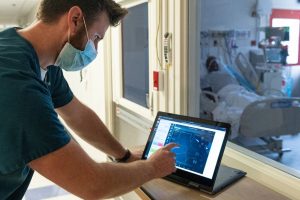
The following was originally posted on The Hub.
A team of Johns Hopkins University and Medicine researchers have built a robotic system that will give medical staff the ability to remotely operate ventilators and other bedside machines from outside intensive care rooms of patients with infectious diseases like COVID-19.
The system is still being tested, but initial trials—including one recently highlighted by NBC Nightly News—have demonstrated how it could be deployed to help hospitals preserve protective gear, limit staff exposure to COVID-19, and provide more time for clinical work.
The invention’s rapid development since its March inception demonstrates the ability of robotics researchers from the university’s Whiting School of Engineering and respiratory clinical staff at Johns Hopkins Hospital to work together to tackle one of the most vexing treatment issues to arise with the pandemic.
“When the crisis began to get very severe, we started to think about what we could do to help,” said robotics professor Russell Taylor, who specializes in computer-integrated interventional medicine and orchestrated the effort. “One of the needs that came through very clearly was the challenge of providing care to patients on ventilators in intensive care units.”
Sajid H. Manzoor, director of adult respiratory therapy at Johns Hopkins Hospital, saw those challenges first-hand and endorsed the concept from its inception.
“Two of the toughest challenges we faced at the peak of COVID-19 were staffing and PPE,” Manzoor said.
The need was identified during March brainstorming sessions that included robotics researchers and medical staff from Johns Hopkins and the University of Maryland and were organized by computer scientist Gregory Hager, director of the Malone Center for Engineering in Healthcare. Those in attendance diagnosed several bottlenecks to delivering care that might benefit from robotic solutions, including testing patients, disinfecting and cleaning, and operating ventilators in ICU rooms.
The pandemic spurred a surge of highly infectious intensive care patients requiring ventilators, infusion pumps, and other equipment. Treating such patients requires hospital personnel to don and doff protective gear every time they enter and leave rooms, even for minor adjustments to machines. The process burns through limited supplies of personal protective equipment. It also wastes valuable time and personnel as the procedure requires an additional person to assist with the changing of gowns, gloves, masks, and other gear.
Routine adjustments typically take just a couple minutes inside a room. But putting on and removing gear added an additional six minutes to the process, said Jonathan Cope, a respiratory therapist who assisted with the project. Doing that 10 times in a single shift steals an entire hour that could have been spent delivering patient care, he said.
“This remote-control system will be a force multiplier for our frontline clinicians,” Cope said. “Being able to save time to deliver more care to more patients will pay huge dividends when we face massive patient surges during pandemics.”
The system may not be ready in time to help deal specifically with COVID-19, but it will be useful in dealing with other infectious diseases.
“It is readily apparent that the need for such remote operation capabilities is not limited to one single disease outbreak, such as COVID-19,” states an application filed for a patent through Johns Hopkins Technology Ventures.
The ongoing process for developing the robotic device began in March and has involved expertise across multiple disciplines—computer science, mechanical engineering, respiratory therapy—spread among faculty, students, and staff from the University of Maryland, Johns Hopkins Medicine, and Johns Hopkins University’s Laboratory for Computational Sensing & Robotics in the Whiting School.
During one March brainstorming session organized by computer science professor Gregory Hager, researchers and clinicians from both universities examined multiple topics but quickly seized on the urgent need for a remote-control option expressed by University of Maryland Shock Trauma Center’s Sarah Murthi and Manzoor.
UM student Misha Khrenov—working under mechanical engineering professor Axel Krieger, who joined Johns Hopkins on July 1—and Johns Hopkins LCSR research scientist Balázs P. Vágvölgyi built the working prototype with assistance from his LCSR colleagues Anton Deguet, Peter Kazanzides, and Taylor.
During a recent test at the Johns Hopkins Hospital Biocontainment Unit, Cope used a touch-screen tablet in a separate room to change the oxygen percentage and volume delivered from a touch-screen ventilator attached to a mannequin in an adjoining room.
The robotic device is affixed to the ventilator’s screen with a horizontal bar secured across the top edge. The bar serves as a stationary track for the back-and-forth movement of two thin vertical bars that extend the full height of the screen. As the vertical bars sweep over the screen, a stylus it carries moves up and down according to commands, similar to how an Etch A Sketch’s drawing tool is steered over an X-Y axis. A camera connected to the top bar sends an image of the screen to the operator’s tablet.
“A few years ago, it would have seemed crazy to control life support equipment remotely,” Cope said. “But not given today’s existing environment. There is a huge need for this. It will definitely end up in the ICU environment in the coming years.”